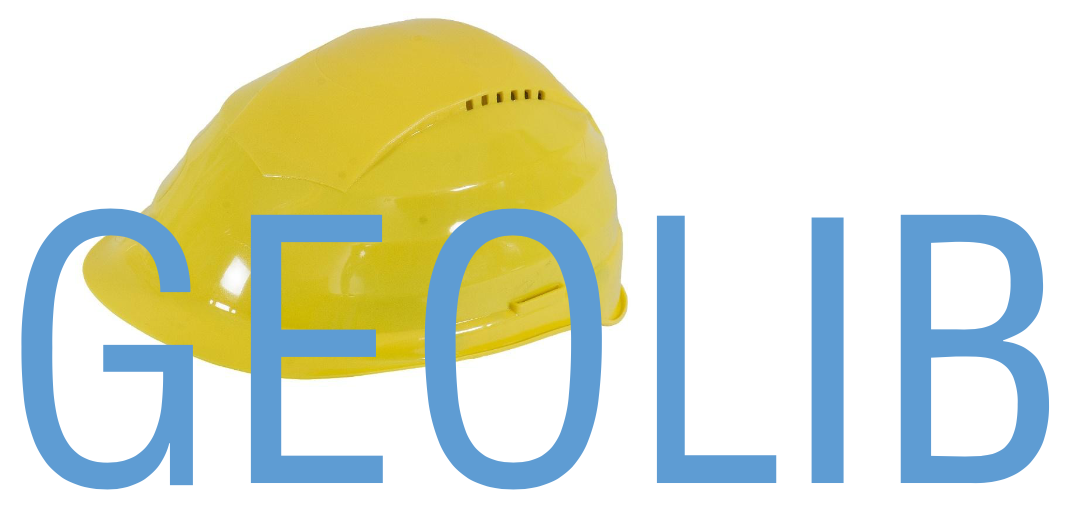Creating a D-Stability model¶
This tutorial will show you how to create a D-Stability model using GEOLib.
The model data should be set. This can be done by initializing the class
DStabilityModel.
from geolib.models.dstability import DStabilityModel
dm = DStabilityModel()
2. Choose an analysis method, such as DStabilityBishopAnalysisMethod and set
it to the model.
from geolib.geometry.one import Point
from geolib.models.dstability.analysis import DStabilityBishopAnalysisMethod, DStabilityCircle
bishop_analysis_method = DStabilityBishopAnalysisMethod(
circle=DStabilityCircle(center=Point(x=20, z=3), radius=15)
)
dm.set_model(bishop_analysis_method)
For completeness, here follow examples for all possible models.
# Bishop Brute Force
dm.set_model(
DStabilityBishopBruteForceAnalysisMethod(
search_grid=DStabilitySearchGrid(
bottom_left=Point(x=15, z=2),
number_of_points_in_x=10,
number_of_points_in_z=10,
space=0.5,
),
bottom_tangent_line_z=-6.0,
number_of_tangent_lines=5,
space_tangent_lines=0.5,
)
)
# Spencer
dm.set_model(
DStabilitySpencerAnalysisMethod(
slipplane=[
Point(x=7, z=2.0),
Point(x=15, z=-3),
Point(x=30, z=-4.5),
Point(x=40, z=0.0),
]
)
)
# Spencer Genetic
dm.set_model(
DStabilitySpencerGeneticAnalysisMethod(
slip_plane_a=[
Point(x=10, z=2.0),
Point(x=15, z=0),
Point(x=30, z=-4),
Point(x=35, z=0.0),
],
slip_plane_b=[
Point(x=5, z=2.0),
Point(x=15, z=-3),
Point(x=30, z=-6),
Point(x=40, z=0.0),
],
)
)
# Uplift-Van
dm.set_model(
DStabilityUpliftVanAnalysisMethod(
first_circle=DStabilityCircle(center=Point(x=5, z=5), radius=9.5),
second_circle_center=Point(x=40, z=2),
)
)
# Uplift-Van Particle Swarm
dm.set_model(
DStabilityUpliftVanParticleSwarmAnalysisMethod(
search_area_a=DStabilitySearchArea(
height=5.0, top_left=Point(x=0.0, z=10.0), width=5.0
),
search_area_b=DStabilitySearchArea(
height=5.0, top_left=Point(x=35.0, z=5.0), width=5.0
),
tangent_area_height=2.0,
tangent_area_top_z=-4.5,
)
)
We can then create a
Soiland add it to the model. Refer to Tutorial Soils for more information.
from geolib.soils.soil import Soil
# add soil
soil = Soil()
soil.name = "Soil test"
soil.code = "HV"
soil.soil_weight_parameters.saturated_weight.mean = 10.2
soil.soil_weight_parameters.unsaturated_weight.mean = 10.2
soil.mohr_coulomb_parameters.cohesion.mean = 0.5
soil.mohr_coulomb_parameters.friction_angle.mean = 15.0
soil_peat_id = dm.add_soil(soil)
Afterwards we create several layers and choose a soil for them.
# add layers
layer_1 = [
Point(x=-50, z=-10),
Point(x=50, z=-10),
Point(x=50, z=-20),
Point(x=-50, z=-20),
]
layer_2 = [
Point(x=-50, z=-5),
Point(x=50, z=-5),
Point(x=50, z=-10),
Point(x=-50, z=-10),
]
layer_3 = [
Point(x=-50, z=0),
Point(x=-10, z=0),
Point(x=30, z=0),
Point(x=50, z=0),
Point(x=50, z=-5),
Point(x=-50, z=-5),
]
embankment = [
Point(x=-10, z=0),
Point(x=0, z=2),
Point(x=10, z=2),
Point(x=30, z=0),
]
layers_and_soils = [
(layer_1, "Sand"),
(layer_2, "H_Ro_z&k"),
(layer_3, "HV"),
(embankment, "H_Aa_ht_old"),
]
layer_ids = []
for layer, soil in layers_and_soils:
layer_id = dm.add_layer(layer, soil)
layer_ids.append(layer_id)
With the geometry defined, let’s add the headlines. One of these can be set as the phreatic line.
# add phreatic line
phreatic_line_id = dm.add_head_line(
points=[
Point(x=-50, z=1.0),
Point(x=0, z=1),
Point(x=30, z=-1),
Point(x=50, z=-1),
],
label="Phreatic Line",
is_phreatic_line=True,
)
# add headline for deep sand
sand_head_line_id = dm.add_head_line(
points=[Point(x=-50, z=5.0), Point(x=50, z=5.0)],
label="Hydraulic head in sandlayer",
)
dm.add_reference_line(
points=[Point(x=-50, z=-3), Point(x=50, z=-3)],
bottom_headline_id=phreatic_line_id,
top_head_line_id=phreatic_line_id,
)
dm.add_reference_line(
points=[Point(x=-50, z=-10), Point(x=50, z=-10)],
bottom_headline_id=sand_head_line_id,
top_head_line_id=sand_head_line_id,
)
What’s left to add is the creation of several types of loads.
from geolib.models.dstability.loads import LineLoad, UniformLoad
from geolib.models.dstability.reinforcements import ForbiddenLine, Geotextile, Nail
# add uniform load
dm.add_load(
UniformLoad(
label="trafficload",
start=6.5,
end=9.0,
magnitude=13,
angle_of_distribution=45,
)
)
# add line load
dm.add_load(
LineLoad(
location=Point(x=2.0, z=2.0),
angle=0.0,
magnitude=10.0,
angle_of_distribution=45.0,
)
)
# create reinforcements NAIL
dm.add_reinforcement(
Nail(
location=Point(x=20.0, z=1.0),
direction=15.0,
horizontal_spacing=1.0,
length=3.0,
grout_diameter=0.1,
max_pull_force=10.0,
plastic_moment=5.0,
bending_stiffness=100.0,
)
)
# create reinforcements GEOTEXTILE
dm.add_reinforcement(
Geotextile(
start=Point(x=20.0, z=0.0),
end=Point(x=30.0, z=0.0),
effective_tensile_strength=10.0,
reduction_area=0.5,
)
)
# create reinforcements FORBIDDEN LINE
dm.add_reinforcement(
ForbiddenLine(start=Point(x=30.0, z=0.0), end=Point(x=30.0, z=-4.0))
)
And we can set state points or state lines.
from geolib.models.dstability.states import DStabilityStateLinePoint, DStabilityStatePoint, DStabilityStress
# state point
dm.add_state_point(
DStabilityStatePoint(
layer_id=layer_ids[2], # HV layer
point=Point(x=0, z=-2.5),
stress=DStabilityStress(pop=10.0),
)
)
# state line
dm.add_state_line(
points=[Point(x=-50, z=-2), Point(x=50, z=-2)],
state_points=[
DStabilityStateLinePoint(
above=DStabilityStress(pop=5), below=DStabilityStress(pop=10), x=20
)
],
)
To run the model first the model needs to be serialized. To do that define a
output file name and call the function serialize().
from pathlib import Path
dm.serialize(Path("tutorial.stix"))
Finally the execute function can be called to run the model in D-Stability.
dm.execute()
In order to get the results of a calculation you can do the following for an Uplift-Van Particle Swarm analysis:
print("Result of scenario 0, calculation 0:")
result = dm.get_result(0, 0)
print("Result type: " + type(result).__name__)
print("Factor of safety: " + str(result.FactorOfSafety))
print("Left center: " + str(result.LeftCenter))
print("Right center: " + str(result.RightCenter))
print("Tangent line: " + str(result.TangentLine))
You can add scenarios, stages and calculations using various methods as demonstrated below. If you set set_current to True, the added item will be set as the default for future calls to the DStabilityModel. If you do not specify scenario_index, it will be added to the current scenario.
# add new scenario (and activate it)
dm.add_scenario("New Scenario", "From GEOLib", set_current=True)
# add new stage to the current scenario (and activate it)
dm.add_stage(label="New Stage 1", set_current=True)
# add new stage to the first scenario (and activate it)
dm.add_stage(scenario_index=0, label="New Stage 2", set_current=True)
# add new stage to the first scenario (and activate it)
dm.add_stage(scenario_index=0, label="New Stage 3", set_current=True)
# add new calculation to the current scenario (and activate it)
dm.add_calculation(label="New Calculation 1", set_current=True)
# add new calculation to the first scenario (and activate it)
dm.add_calculation(scenario_index=0, label="New Calculation 2", set_current=True)
The GEOLib package also contains functionality to plot a D-Stability model. To plot the model you can use the following code:
import matplotlib.pyplot as plt
scenario_id = 0
stage_id = 0
fig, ax = dm.plot_model(scenario_id, stage_id)
plt.show()
